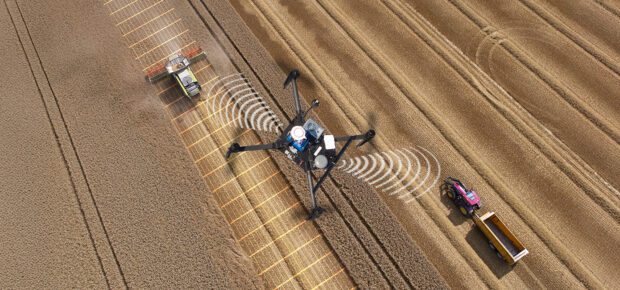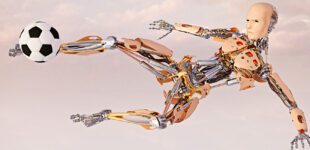March 6, 2025
Drones are soaring to new heights in today’s tech landscape.
Once viewed as futuristic gadgets, drones have found robust applications elsewhere. From revolutionizing agriculture to transforming construction and insurance, drones are proving their worth.
Agriculture stands as one of the biggest beneficiaries of drone technology. But they’re making waves in diverse sectors like public safety, construction, insurance, entertainment and infrastructure inspection.
The IEEE Computer Society’s comprehensive list of technology predictions identified drone adoption as one of the top technologies in 2025, right behind the adoption of large language models.
Drones in Agriculture
Drones are used in various ways in the agricultural sector. When outfitted with sensors, they can perform low-cost analysis of soil conditions, monitor for the presence of diseases, pests, and weeds and evaluate the health of plants. They’ve also been deployed for irrigation and to spray fertilizer and pesticides in a waste-reducing practice known as precision agriculture.
“Certain types of farming benefit more from drone technology than others,” said IEEE Senior Member Inderpreet Kaur. “Large-scale crop farming like wheat, corn and rice gain efficiency as drones monitor vast fields, assess crop health and manage resources. Orchard and vineyard management also see advantages, as drones help monitor tree and vine health, optimize irrigation and detect diseases early.”
The subject of drones in agriculture has been a significant area of scholarly research over the past decade. For an article that appeared in IEEE Access, researchers searched databases of scholarly articles for entries that contained the words “unmanned aerial vehicle” (another term for drones), and “agriculture.” They found that 4,621 articles contained both those terms in 2022, up from about 900 in 2017. They also found more than 1,400 that contained both terms in the title.
Driving the Adoption of Drones
Advancements in hardware, including longer-lasting batteries and compact, high-quality sensors, have made drones more powerful and versatile. Meanwhile, enhanced GPS systems and real-time data transmission through IoT technology enable drones to gather and share information quickly, improving decision-making across industries.
Much like smartphone cameras, drone sensors have become smaller without sacrificing quality. In addition to capturing visible light for imagery, many drones contain multispectral and hyperspectral sensors to capture data not visible to the naked eye.
For guidance, drones now rely on an array of advanced GPS sensors, inertial measurement units and visual positioning systems that use cameras and computer vision to navigate and maintain stability in areas where GPS is unreliable.
Lastly, improved connectivity has been a boon to drone users. Drones can communicate with sensors and other devices on the ground. In agriculture, for example, they may gather data from soil moisture sensors in the field. They also need to send the data they collect somewhere, like to a person watching a screen or to a data center. The improvements in how drones communicate have also helped make them more useful, as they can quickly send the data they collect to be processed and analyzed.
“IoT technologies are crucial for real-time data gathering, sharing, and analysis,” said IEEE member Juan Galindo.
Leading Drone Applications
Aside from agriculture, public safety applications like search and rescue have emerged as leading applications.
According to a review of drones used by the U.S. Coast Guard that appeared in IEEE Computer Magazine, drones are less expensive to operate and can often be launched faster than it takes to assemble helicopter crews for oceanic rescues.
In the construction industry, building contractors can use drones to quickly measure land and buildings, which helps them rapidly determine the cost of jobs. In the energy sector, drones inspect everything from wind turbine blades to power transmission lines to critical infrastructure like hydroelectric dams. In the mining sector, drones are used to estimate the size of stockpiles.
Insurance companies use drones to rapidly assess damage after major disasters, and also to evaluate properties before offering new insurance policies.
Who Operates the Drones
In most cases, drones are operated by trained pilots, many of whom operate small businesses by performing services to various sectors.
“While some tech-savvy farmers are learning to use drones themselves, many prefer hiring certified drone pilots due to the technical skills required for operation, maintenance and compliance with regulations,” Kaur said. “In some regions of India, government and private organizations are providing training to farmers to use drones. For instance, a group of 20 women from Punjab, India, have been trained as drone pilots to spray fertilizer on farmlands. These women received free drone units, empowering them to manage their fields and reduce manual labor efficiently.”
Future Innovations in Drone Technology
Despite their rapid uptake, some aspects of drone technology leave room for improvement.
Battery technology is the subject of significant research. Many drones can only fly for 20 to 40 minutes before they need to be recharged. More powerful motors and lighter materials would increase payloads, allowing drones to carry more weight.
And some improvements could benefit different applications. Better LiDAR and mapping capabilities could help evaluate construction progress, while quieter drones would improve their use in entertainment and media.
Learn More: Like their robot cousins, some drones are inspired by examples from the natural world. Check out this drone featured in IEEE Spectrum, which walks like a bird on the ground to conserve energy.





 Meaningful Momentum or Running in Place?
Meaningful Momentum or Running in Place? AI Through Our Ages
AI Through Our Ages Liquid Infrastructure: Our Planet's Most Precious Resource
Liquid Infrastructure: Our Planet's Most Precious Resource The Impact of Technology in 2025
The Impact of Technology in 2025 Quantum and AI: Safeguards or Threats to Cybersecurity?
Quantum and AI: Safeguards or Threats to Cybersecurity? Why AI Can't Live Without Us
Why AI Can't Live Without Us Bits, Bytes, Buildings and Bridges: Digital-Driven Infrastructure
Bits, Bytes, Buildings and Bridges: Digital-Driven Infrastructure Impact of Technology in 2024
Impact of Technology in 2024 Emerging AI Cybersecurity Challenges and Solutions
Emerging AI Cybersecurity Challenges and Solutions The Skies are Unlimited
The Skies are Unlimited Smart Cities 2030: How Tech is Reshaping Urbanscapes
Smart Cities 2030: How Tech is Reshaping Urbanscapes Impact of Technology 2023
Impact of Technology 2023 Cybersecurity for Life-Changing Innovations
Cybersecurity for Life-Changing Innovations Smarter Wearables Healthier Life
Smarter Wearables Healthier Life Infrastructure In Motion
Infrastructure In Motion The Impact of Tech in 2022 and Beyond
The Impact of Tech in 2022 and Beyond Cybersecurity, Technology and Protecting Our World
Cybersecurity, Technology and Protecting Our World How Technology Helps us Understand Our Health and Wellness
How Technology Helps us Understand Our Health and Wellness The Resilience of Humanity
The Resilience of Humanity Harnessing and Sustaining our Natural Resources
Harnessing and Sustaining our Natural Resources Creating Healthy Spaces Through Technology
Creating Healthy Spaces Through Technology Exceptional Infrastructure Challenges, Technology and Humanity
Exceptional Infrastructure Challenges, Technology and Humanity The Global Impact of IEEE's 802 Standards
The Global Impact of IEEE's 802 Standards Scenes of our Cyber Lives: The Security Threats and Technology Solutions Protecting Us
Scenes of our Cyber Lives: The Security Threats and Technology Solutions Protecting Us How Millennial Parents are Embracing Health and Wellness Technologies for Their Generation Alpha Kids
How Millennial Parents are Embracing Health and Wellness Technologies for Their Generation Alpha Kids Space Exploration, Technology and Our Lives
Space Exploration, Technology and Our Lives Global Innovation and the Environment
Global Innovation and the Environment How Technology, Privacy and Security are Changing Each Other (And Us)
How Technology, Privacy and Security are Changing Each Other (And Us) Find us in booth 31506, LVCC South Hall 3 and experience the Technology Moon Walk
Find us in booth 31506, LVCC South Hall 3 and experience the Technology Moon Walk Virtual and Mixed Reality
Virtual and Mixed Reality How Robots are Improving our Health
How Robots are Improving our Health IEEE Experts and the Robots They are Teaching
IEEE Experts and the Robots They are Teaching See how millennial parents around the world see AI impacting the lives of their tech-infused offspring
See how millennial parents around the world see AI impacting the lives of their tech-infused offspring Take the journey from farm to table and learn how IoT will help us reach the rising demand for food production
Take the journey from farm to table and learn how IoT will help us reach the rising demand for food production Watch technical experts discuss the latest cyber threats
Watch technical experts discuss the latest cyber threats Explore how researchers, teachers, explorers, healthcare and medical professionals use immersive technologies
Explore how researchers, teachers, explorers, healthcare and medical professionals use immersive technologies Follow the timeline to see how Generation AI will be impacted by technology
Follow the timeline to see how Generation AI will be impacted by technology Learn how your IoT data can be used by experiencing a day in a connected life
Learn how your IoT data can be used by experiencing a day in a connected life Listen to technical experts discuss the biggest security threats today
Listen to technical experts discuss the biggest security threats today See how tech has influenced and evolved with the Games
See how tech has influenced and evolved with the Games Enter our virtual home to explore the IoT (Internet of Things) technologies
Enter our virtual home to explore the IoT (Internet of Things) technologies Explore an interactive map showcasing exciting innovations in robotics
Explore an interactive map showcasing exciting innovations in robotics Interactively explore A.I. in recent Hollywood movies
Interactively explore A.I. in recent Hollywood movies Get immersed in technologies that will improve patients' lives
Get immersed in technologies that will improve patients' lives